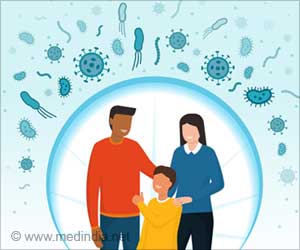Hospitalization of adolescents will reduce once they are back to school and engage with friends and activities that are meaningful to them.

‘Hospitalization of adolescents will reduce once they are back to school and engage with friends and activities that are meaningful to them.’





The 125 hospitalizations among patients ages 10-23 at Michigan Medicine in those 12 months reflect a significant increase over previous years, as admissions related to eating disorders during the same timeframe between 2017 and 2019 averaged 56 per year."These findings emphasize how profoundly the pandemic has affected young people, who experienced school closures, cancelled extracurricular activities, and social isolation. Their entire worlds were turned upside down overnight," said lead author Alana Otto, M.D., M.P.H., an adolescent medicine physician at University of Michigan Health C.S. Mott Children's Hospital.
"For adolescents with eating disorders and those at risk for eating disorders, these significant disruptions may have worsened or triggered symptoms."
Findings may be the Tip of the Iceberg
But the numbers may represent only a fraction of those with eating disorders affected by the pandemic, researchers said, as they only included young people whose severe illness led to hospitalization.
Advertisement
The study also suggests the rate of admissions at the institution steadily increased over time during the first year of the pandemic. The highest rates of admissions per month occurred between nine and 12 months after the pandemic began, with rates continuing to climb when the study period ended in March 2021.
Genetics, psychological factors, and social influences have all been linked to developing eating disorders and adolescents with low self-esteem or depressive symptoms are at especially high risk.
Changes to adolescents' day-to-day lives during the pandemic, such as school closures and cancellation of organized sports, may also disrupt routines related to eating and exercise, and be an impetus for developing unhealthy eating behaviors among those already at risk, Otto said.
"A stressful event may lead to the development of symptoms in a young person at risk for eating disorders," she said.
"During the pandemic, the absence of routine, disruptions in daily activities and a sense of a loss of control are all possible contributing factors. For many adolescents, when everything feels out of control, the one thing they feel they can control is their eating."
Some patients also reported that limitations in playing sports and other physical activities made them worry about gaining weight, leading to unhealthy dieting or exercise. Increased social media use during the pandemic may also expose young people to more negative messaging about body image and weight.
There could be indirect connections to the pandemic as well, Otto said. For example, an adolescent with significant eating disorder symptoms and severe malnutrition may have only come to medical attention when they moved back in with their parents after their college closed unexpectedly during the shutdowns.
Increased Demand but Limited Access to Care
Another potential factor may be delayed care for non-COVID-19 conditions, including eating disorders, and fewer in-person visits as part of measures to reduce transmission risks, authors noted.
Adolescents with eating disorders may be particularly impacted by reduced availability of in-person care, Otto said. Assessment and management of patients with malnutrition generally requires measuring weight and vital signs and may involve a full physical examination or lab tests.
Confidentiality, a critical component of clinical care for adolescents, may also be limited in virtual settings.
While the study is limited by its small sample size, it comes as international reports indicate increases in both outpatient referrals to child and adolescent eating disorder services and inpatient admissions related to anorexia nervosa among adolescents, Otto said.
"Although our findings reflect the experience of a single institution, they're in line with emerging reports of the pandemic's potential to have profound negative effects on the mental and physical health of adolescents across the globe," Otto said.
"Adolescents may be particularly vulnerable to negative effects of societal upheaval related to the pandemic and to developing eating disorders during the COVID-19 era. Providers who care for adolescents and teens should be attuned to these risks and monitor patients for signs and symptoms of an eating disorder."
Patient demographics were similar before and during the pandemic, according to the study. But patients admitted during the COVID-19 pandemic were less likely than those admitted prior to the pandemic to have public insurance, something that should be studied further, authors said.
Otto noted that for adolescents with eating disorders, medical admission is often the beginning, not the end, of treatment, which can be a long journey. Among the biggest barriers to care are a shortage of qualified providers and insurance coverage gaps.
"Access to care was already limited before the pandemic and now we're seeing an increased demand for these services. As we see a wave of young people coming to the hospital for urgent medical concerns related to eating disorders, we need to be prepared to continue to care for them after they leave the hospital," Otto said.
"I'm hopeful that as adolescents are able to go back to school and engage with friends and activities that are meaningful to them, we will see admissions decrease," she added. "But it takes time for these symptoms to develop and eating disorders generally last for months or years.
"We expect to see downstream effects of the pandemic on adolescents and young people for some time."
Source-Eurekalert














